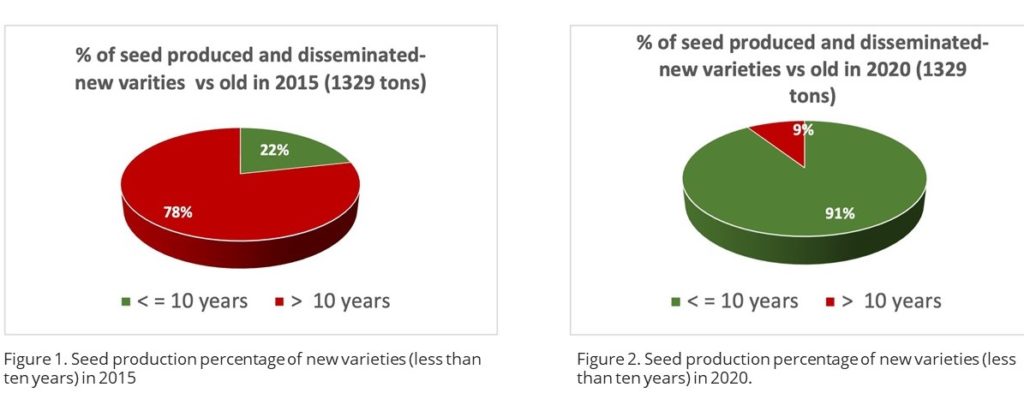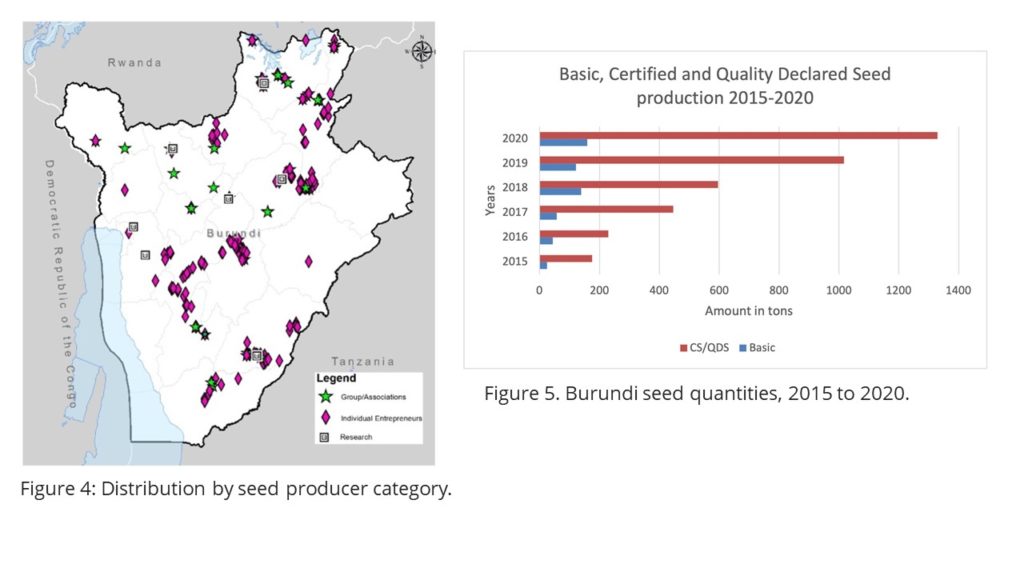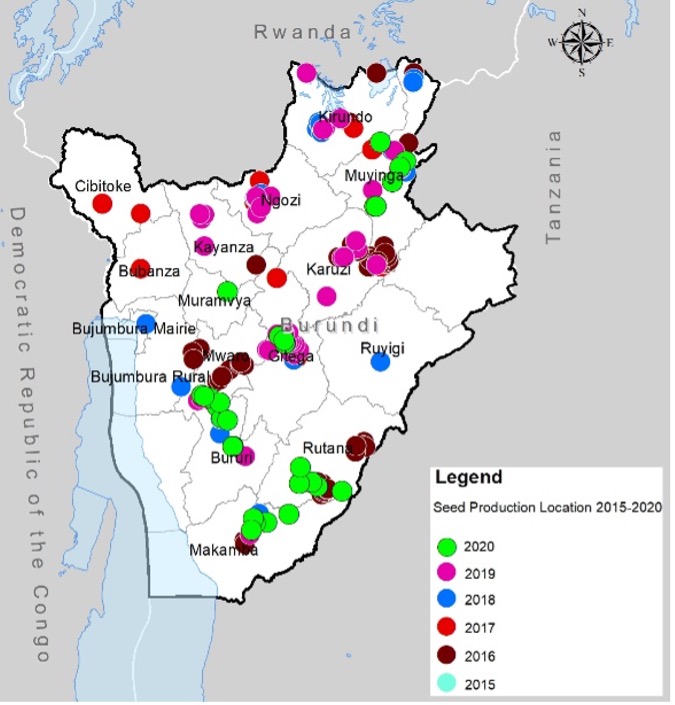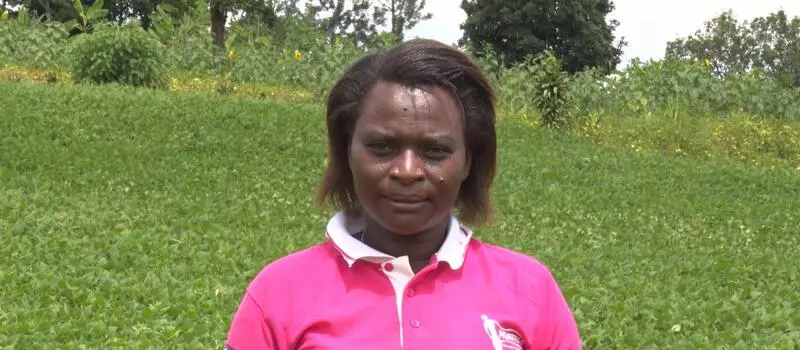by Sylvia Kalemera, Eric Nduwarugira, Nepomuscene Ntukamazina, Blaise Ndabashize, Noel Templer, Kessy Radegunda, Fadhili Kasubiri, Patricia Onyango and Jean Claude Rubyogo.
Burundi is a landlocked country. Its economy depends mainly on agriculture, which contributes around 40 percent of the gross domestic product, employs 84 percent of the labor force and contributes to more than 95 percent of the food supply.
Common bean (Phaseolus vulgaris L.) is an important crop for food and nutrition, cash, and agroecosystem improvement in Burundi. The crop is often cultivated by small-scale farmers, with 86 percent of the households farming less than 0.5 hectare in association with other crops or as a sole crop. Common bean occupies 599,139 hectares (40 percent) of the country’s cultivated land.
The crop is vital for the nutritional security of Burundian households, providing 50 percent of the protein and approximately 20 percent of calories in the diet. The current average bean consumption is estimated at about 30 kilograms per person per year.
Bean seed systems in Burundi are predominantly informal. One of the major challenges to increase productivity in Burundi is the access to quality seeds of climate-resilient bean varieties in sufficient quantities and adapted to various agro-ecological conditions. The Ministry of Agriculture, Environment and Animal Husbandry indicated the low use of good quality seeds is due to limited availability of high-performing varieties that meet farmers’ and consumers’ demands. It is also due to the failure of the seed production chain, insufficient information on the importance of good quality seeds and low purchasing power of farmers. An effective seed supply system is necessary to make good-quality seeds available to farmers at the right time and at low cost.
Through the Pan-Africa Bean Research Alliance (PABRA), the Institut des Sciences Agronomiques du Burundi (ISABU), in collaboration the Alliance of Bioversity International -CIAT deployed new participatory approaches to address the above challenges. The deployment was financially supported by the Swiss Agency for Development and Cooperation, with complementary funding from Global Affairs Canada, the government of Burundi and various development partners, including small farm-based enterprises. The efforts of building sustainable bean seed systems focused on the following areas:
- Releasing bean varieties that farmer/ consumer demanded and climate resilient.
- Participatory prioritization of these varieties by bean value chain actors.
- Demand creation on the benefit of using new varieties and complementary climate smart production techniques.
- Increasing early generation of prioritized varieties.
- Aligning and synchronizing seed and grain production of prioritized varieties.
- Capacity-building of local seed entrepreneurs and grain producer farmers.
- Integrating various seed approaches and making bean seed accessible and affordable to the poor majority.
- Robust monitoring, evaluation and learning to facilitate sharing of lessons and influencing other investments in the value chain. Implementation has been one of the major success stories in the country and to their collaborators.
Collaboration from development to dissemination
The PABRA model recognizes the importance of participatory approaches from bean varietal development to bean variety dissemination and use. Bean value actors are closely engaged in every stage, i.e., screening, release, promotion, seed dissemination, grain production and marketing. This participation ensures accelerated and higher adoption rate of improved bean varieties and sustainable seed systems. The approach helps in coordinating all efforts in bean value chain development.
Presented below are the impacts resulting from collaborative efforts undertaken within the seed systems through several innovations on seed production and delivery led by PABRA (ISABU and the Alliance of Bioversity International-CIAT) in partnership with the development organizations and private sectors to improve the situation.
Data were collected from the total of 75 seed entrepreneurs from 15 provinces using Open Data Kit and ONA applications by the ISABU and the Alliance teams from 2015 to 2020. Analysis was done through Microsoft Excel while spatial analysis and map production was performed on ESRI Arc Map, version 10.5.
Seed selection is critical
Selecting a suitable variety is an important decision to smallholder farmers. Most farmers produce grain to respond to consumer and market demands; providing an extensive choice of improved varieties is therefore vital. Through its bean research, PABRA recognizes the importance of implementing demand-led bean research where the involvement of key actors such as the bean grain traders (offtakers) is critical, and their bean-related issues become a focus. Multistakeholder platform meetings, attended by seed entrepreneurs, farmer cooperatives, nongovernmental organizations and grain offtakers and traders from several provinces helped ISABU bean researchers determine the suitable material preferred by the market.
Based on value chain actors’ variety demands and agroecological conditions, germplasm that possesses the desired traits is shipped to Burundi from Uganda (Kawanda, PABRA regional breeding hub and germplasm resource center). Other options for accessing germplasm are from the other PABRA member countries under its networks, such as the Eastern and Central Africa Bean Research Network, of which Burundi is a member.
The variety participatory selection was carried across various agroecologies, where key actors selected the best performing line(s) that best fit their environment, market and consumption. The processes were completed with the release procedures by the National Office of Control and Seed Certification. The newly released varieties were promoted in partnerships with local seed entrepreneurs and farmer organizations supported by nongovernmental organizations. This helps to quicken the variety supply and dissemination based on farmers’ demand and build foundation for sustainable bean seed systems. The following results were attained:
- Productivity increase and old variety replacement
Given the critical role of improved varieties in increasing the quantity and quality of the grain, releasing nutritious bean varieties that can withstand climate change related stresses and increasing productivity given the shrinking availability of land was critical. This observation prompted PABRA breeders to breed for high yielders and climate-resilient varieties that could withstand climatic variability. Based on the seed system data collected between 2015 and 2020, a total of 24 (16 climbers’ type, eight biofortified, and eight climate-smart) varieties have been released since 2015. The climber type yields is three times more than the bush type. Climate-smart varieties released are early maturing and tolerant to drought and diseases. These new higher-yielding varieties have contributed to increased productivity: 1.8 tons per hectare versus an average of 0.75 tons per hectare before the interventions.
Among the 24 newly released, 12 varieties are already in the farmers’ hands. This variety turnover was made possible through collaborations among research, farmer cooperatives, individual seed entrepreneurs, and non-governmental organizations that helped in variety promotion and dissemination across countries using demonstration plots, bean platforms, and other channels. Seed system data analyzed since the project’s inception in 2015 to 2020 show that old varieties were replaced by new varieties from 22 percent in 2015 to 91 percent in 2020 (Figures 1 and 2).

2. Increased access to certified seed varieties through public and private partnership
As partners work together, the definition of their responsibilities becomes more transparent and more complementary and recognizes that seed demands cannot be met by individual effort but rather by actors along the bean value chain. In Burundi, 100 percent of breeder and pre-basic bean seeds are produced by ISABU which supplies the seed to competent decentralized individual seed entrepreneurs who produce basic seed.
Subsequently, basic seed is supplied to farmers’ associations, individual seed entrepreneurs or cooperatives (Figures 4) who multiply them into certified and quality declared seeds (Figure 5).

Certified and quality declared seed is later sold to farmers producing bean grains for consumption or sale. Since 2015, ISABU and the Alliance has dedicated their efforts to capacity-building of seed producers on seed production, storage and marketing. These engagements have helped seed entrepreneurs improve the seed quality and expand their seed businesses, leading to seed quantity increase and dissemination (Figure 6).

New and improved bean varieties must be accessible to communities to accelerate the adoption. Most farmers in Burundi are poor and own small plots with low seed access due to limited purchasing power. Introducing affordable seed packages was therefore very crucial. PABRA introduced a seed delivery model of affordable and small packs sizes of 1 kilogram, 2 kilograms, 5 kilograms, and 10 kilograms to seed entrepreneurs to improve seed access to smallholder farmers. Since then, the number of farmers accessing seed has increased from 17,558 in 2015 to 1,329,000 in 2020 (60 percent women). Nevertheless, time between release and use has decreased from five to three years. This implies that now farmers are accessing new improved varieties much faster that it was five years ago.
3. Established business linkages among bean seed producers with other development partners
With geographical information system aid, seed producers were mapped seasonally and yearly. Similarly, seed movement was tracked, primarily when the identified bean seed entrepreneurs conducted the business. It was noted that since 2017, there had been seed exchange among producers, which was validated through spatial analysis (Figure 7). The study revealed that the closest seed business was conducted within 0.065 kilometers while the furthest was 74 kilometers. This observation validated the seed producer linkage facilitated by ISABU and PABRA; private seed producers see opportunities to invest in beans.

The participatory approach combined with other seed delivery innovations deployed within the seed system since 2015 has helped Burundi in accelerating the process of getting seed in the hands of farmers, linking seed and nonseed partners and making seed easily accessible and affordable. The nutritious, climate-smart bean varities will help improve nutritional status, increase household income and generate government revenues.
Next steps
Though good progress in accessing new varieties has made, several areas gaps exist, particularly synchronizing seed production to grain production and grain demand to sustain the momentum. The use of a bean corridor offers a platform for better coordination between seed and grain production. The approach will facilitate demand-led breeding linked to seed systems. The approach also will help the dispersed smallholder producers who will be integrated into bean value chains. Their presence in turn will catalyze demand for quality seed of improved varieties to respond to bean trade demand. The platform also facilitates better targeting of provision of inputs (e.g. fertilizers, pesticides, mechanization, investment) and access to grain market through digitalization services.
The work in this report was funded under the Swiss Agency for Development and Cooperation and the Global Affairs Canada project through the Pan-Africa Bean Research Alliance program led by the Alliance of Bioversity International-CIAT. Special thanks to the bean team at the Institut des Sciences Agronomiques du Burundi and its partners, farmers, seed producers and nongovernmental organizations who were actively engaged in the project at various stages, as well as the government of Burundi for being very supportive in the whole process.

